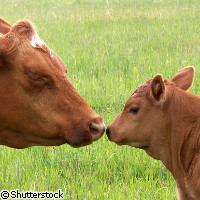Gene linked to increased birth weight in cattle
Researchers from Germany and Japan have identified a genetic mechanism in cattle that is linked to major differences in prenatal growth. The discovery will help breeders and scientists understand the reasons behind abnormally large foetal growth, an issue that significantly affects the cattle industry. Results from the study are published in the Genetics Society of America's journal Genetics. The finding represents a collaborative effort between five institutes in Germany and Japan: the Leibniz-Institute for Farm Animal Biology (FBN), Helmholtz Zentrum München, the Technical University of Munich, the Shirakawa Institute of Animal Genetics, and the Cattle Breeding Development Institute of Kagoshima Prefecture. The study is part of SEGFAM ('Segregating families'), a long-term research project into growth and lactation in cattle. The subject of the team's discovery is a genetic variant in the NCAPG (non-synonymous polymorphism in the non-SMC condensin I complex, subunit G) gene on bovine chromosome 6. One of the NCAPG variants detected was significantly linked with foetal growth in the womb. FBN's Dr Christa Kühn explained that from an evolutionary perspective, the variant in the NCAPG gene seems rather young. 'It is, however, already distributed across many breeds. The function of the gene in mammals has been largely unknown, although it is described to be involved in cell division in lower organisms like the fruit fly,' said Dr Kühn. Over 700 Charolais and German Holstein cattle (beef and dairy respectively), were involved in the study; these are breeds known to differ considerably in regard to foetal growth. A first progeny generation (F1) was generated by artificial insemination and embryo transfer. This was followed by a second progeny generation (F2), which was generated by mating F1 cattle. The underlying question for the team was to determine the genetic variation that is relevant for high body weight of calves in the womb. As a result of their research, it may now be possible for cattle breeders to detect a genetic variant through a conventional genetic test. In turn, this will allow industry stakeholders to target future cattle selection so as to reduce the cases of calves with high birth weight. Several studies have found that the postnatal life of a mammal that had recorded high prenatal growth could be problematic. Furthermore, increased birth weight for a calf often results in impaired delivery and even still birth. Understanding this growth, therefore, has long been a goal for industry stakeholders, including actors in the field of animal health and breeding. In the current study, the authors explain that greater understanding of the factors controlling fetal growth 'would assist artificial reproduction and conventional animal breeding and also would contribute to an increased knowledge of pathways regulating fetal development'. Two directions have been identified for future study on the NCAPG gene in cattle: more research on the potential of the genetic test, and on the gene's functional mechanisms.
Countries
Germany, Japan



